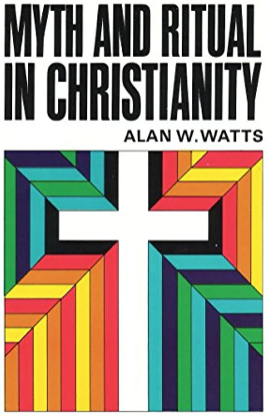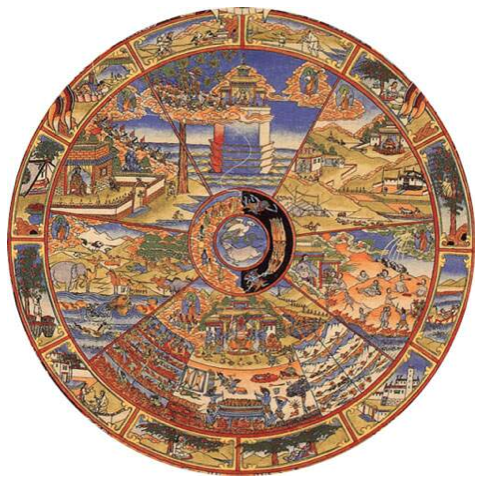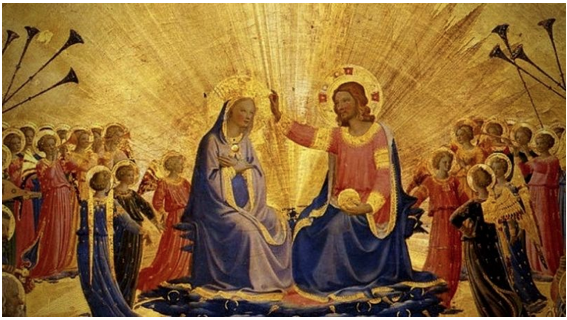Excerpted from a review of Alan Watts's "Myth and Ritual in Christianity" by Revd Fr Giovanni Pede
This book is a useful tool for understanding the relationships between Christianity and other traditions (Alan Watts was a Buddhist and writes about Christianity, validating its deeper meaning) and how they can all be traced back to a single source, the perennial philosophy. External differences of doctrines are matched when one searches for the true meaning of the myth, they vanish when one looks at the experience of the mystics and those who have realised their true nature, those who have realised the non-duality of reality.
Distant peoples have similar symbols and images in their myths. Man, however different, draws true Knowledge from the same source: what Jung calls the collective unconscious, which is probably nothing more than a supra-individual state of being that transcends the limits of time and space of the single individuals who are part of it.
Christian myths are no exception. They contain universal truths. They are narratives of the one Tradition.
There is a problem, however, as Watts points out. Christians tend to interpret the stories literally and not see the deeper meaning hidden behind them. Moreover, there is a certain 'Christian provincialism' that leads the faithful (and the authorities) to exclude any manifestation of the perennial philosophy other than their own. This is true for Catholics and Orthodox, but also for Protestant denominations. In the latter case perhaps even more so because they are much more constrained by biblical theology and literalism.
However, a specific point must be made. It is true that Christians tend to interpret the mythology of their faith literally and historically. But - and herein lies the uniqueness of Christianity - it is equally true that the stories underlying this mythology have their own place in space and time. They have an undeniable historicity. We have, in christianity, a real mixture of universal reality and contingent reality. We can speak of a Historical Jesus, because there was a Jesus born in Nazareth, an itinerant preacher who challenged the religious status quo and was put to death at the time of Pilate. This is not surprising: just as the macrocosm is reflected in the microcosm of man, i.e. in the reality of the individual, so must it find correspondence in the reality of a multitude of individuals, and this reality is history. As the author rightly points out, the birth of Christ is a historical fact. History has eternal value only if it also becomes myth, where past facts symbolise present reality.
That is why in history we find the incarnation of cosmic principles such as the Logos and Prima Materia as a correspondence with what was in the beginning.
According to the author, the problem of the Western world is that it has tried to explain the ineffable reality that precedes the facts with science, the same science that is used to investigate the facts. Metaphysics cannot have language and its knowledge comes through intuition, contrary to the rational and sensitive knowledge typical of science. This has created confusion and, as Plato would say, knowledge based more on opinion than on True Science.
Actually, metaphysics needs no explanation as it is a type of knowledge already present in man. The problem is that man is distracted, he is off centre. He is focused on illusions and conventions, such as the ego, the illusion of the future, pleasures and, generally, chasing after wind (Ecclesiastes 1, 14).
The myth of the Tower of Babel warns against trying to understand ultimate reality with only the intellect. Metaphysics approached with rationality and verbal language only creates confusion. In the myth of Babel, God punishes man's arrogance by confusing languages. Pentecost is the antithesis: the man who realises his nature, who lets go of the ego to make room for the Spirit, has the gift of speaking in languages, understands (by intuition) reality as it is.
In essence, the problem of the western vision lies in theology itself: like all positive sciences, it measures everything in human terms and carries with it all the preconceptions derived from human perception. One of these is time, that for us is something linear. From this cognition of time comes the conception we have, for example, of eternity: an infinite extension of time. Eternity should be understood as outside time, in an atemporal dimension. And even time itself is not really linear, but circular as events tend to be cyclical (eternal cycle of life and death, history that is cyclical, economy as well).
Distant peoples have similar symbols and images in their myths. Man, however different, draws true Knowledge from the same source: what Jung calls the collective unconscious, which is probably nothing more than a supra-individual state of being that transcends the limits of time and space of the single individuals who are part of it.
Christian myths are no exception. They contain universal truths. They are narratives of the one Tradition.
There is a problem, however, as Watts points out. Christians tend to interpret the stories literally and not see the deeper meaning hidden behind them. Moreover, there is a certain 'Christian provincialism' that leads the faithful (and the authorities) to exclude any manifestation of the perennial philosophy other than their own. This is true for Catholics and Orthodox, but also for Protestant denominations. In the latter case perhaps even more so because they are much more constrained by biblical theology and literalism.
However, a specific point must be made. It is true that Christians tend to interpret the mythology of their faith literally and historically. But - and herein lies the uniqueness of Christianity - it is equally true that the stories underlying this mythology have their own place in space and time. They have an undeniable historicity. We have, in christianity, a real mixture of universal reality and contingent reality. We can speak of a Historical Jesus, because there was a Jesus born in Nazareth, an itinerant preacher who challenged the religious status quo and was put to death at the time of Pilate. This is not surprising: just as the macrocosm is reflected in the microcosm of man, i.e. in the reality of the individual, so must it find correspondence in the reality of a multitude of individuals, and this reality is history. As the author rightly points out, the birth of Christ is a historical fact. History has eternal value only if it also becomes myth, where past facts symbolise present reality.
That is why in history we find the incarnation of cosmic principles such as the Logos and Prima Materia as a correspondence with what was in the beginning.
According to the author, the problem of the Western world is that it has tried to explain the ineffable reality that precedes the facts with science, the same science that is used to investigate the facts. Metaphysics cannot have language and its knowledge comes through intuition, contrary to the rational and sensitive knowledge typical of science. This has created confusion and, as Plato would say, knowledge based more on opinion than on True Science.
Actually, metaphysics needs no explanation as it is a type of knowledge already present in man. The problem is that man is distracted, he is off centre. He is focused on illusions and conventions, such as the ego, the illusion of the future, pleasures and, generally, chasing after wind (Ecclesiastes 1, 14).
The myth of the Tower of Babel warns against trying to understand ultimate reality with only the intellect. Metaphysics approached with rationality and verbal language only creates confusion. In the myth of Babel, God punishes man's arrogance by confusing languages. Pentecost is the antithesis: the man who realises his nature, who lets go of the ego to make room for the Spirit, has the gift of speaking in languages, understands (by intuition) reality as it is.
In essence, the problem of the western vision lies in theology itself: like all positive sciences, it measures everything in human terms and carries with it all the preconceptions derived from human perception. One of these is time, that for us is something linear. From this cognition of time comes the conception we have, for example, of eternity: an infinite extension of time. Eternity should be understood as outside time, in an atemporal dimension. And even time itself is not really linear, but circular as events tend to be cyclical (eternal cycle of life and death, history that is cyclical, economy as well).
This has repercussions on the eschatological vision. The Kingdom, eternal life, is projected into an indefinite future. Something that has to come, that has to be realised in time, rather than something that is realisable within us (Luke 17, 20-21) and is realisable in the present, provided that we can at least manage to stop identifying ourselves with the heap of memories that constitute the past and with the expectations, dreams, illusions that project the self into the future. As the myths remind us, salvation always becomes a liberation from the slavery of the past: think of Israel's liberation from Egypt.
The incarnation itself is to be understood not as an event of the past, but as an event that is out of time and that reproduces itself eternally in the present moment.
Pentecost should be seen in the same light. It was not a unique and unrepeatable event, but is reproduced inwardly where the ego identifies itself with the divine Self. Just as the Spirit does not descend until Jesus has ascended, so until the ego is emptied, the spirit cannot descend to fill this void. There is no divinisation of man until he recognises his eternal nature and realises how attached he is to his illusory reality.
Talking about eschatology, eternal damnation is something that is not really convincing. As Watts rightly says, a reality in which supposed eternity still contrasts a Heaven (where the good are) and a Hell (where the bad are) still presupposes a dual reality. I see Hell and Paradise as realities that are realised now, in the sensible world we live in and perhaps in other states that are not the ultimate reality. I agree with Watts that the “sense” of heaven and hell are to be found in samsara and its cyclical nature. The cycle of samsara is eternal as long as one travels through life along the circumference. The purpose of life is to seek the way to the centre, the only eternal and unchanging point, from which one has a marvellous view of everything that moves around.
The incarnation itself is to be understood not as an event of the past, but as an event that is out of time and that reproduces itself eternally in the present moment.
Pentecost should be seen in the same light. It was not a unique and unrepeatable event, but is reproduced inwardly where the ego identifies itself with the divine Self. Just as the Spirit does not descend until Jesus has ascended, so until the ego is emptied, the spirit cannot descend to fill this void. There is no divinisation of man until he recognises his eternal nature and realises how attached he is to his illusory reality.
Talking about eschatology, eternal damnation is something that is not really convincing. As Watts rightly says, a reality in which supposed eternity still contrasts a Heaven (where the good are) and a Hell (where the bad are) still presupposes a dual reality. I see Hell and Paradise as realities that are realised now, in the sensible world we live in and perhaps in other states that are not the ultimate reality. I agree with Watts that the “sense” of heaven and hell are to be found in samsara and its cyclical nature. The cycle of samsara is eternal as long as one travels through life along the circumference. The purpose of life is to seek the way to the centre, the only eternal and unchanging point, from which one has a marvellous view of everything that moves around.
I found very interesting the reflection on the figure of Mary and its correspondence with the oriental concept of Maya, the non-thing that when dismembered becomes things, the first uncreated matter at the basis of creation, immaculate, that is not altered by the passage of contingent, created things, and always remains virgin. This first matter represents the very nature given to Christ in his incarnation and is therefore our very nature. Man's realisation involves the realisation of this true nature of his, from the beginning immaculate. This "cosmic" correspondence of Mary supports the thesis that sees the Virgin as a co-redemptrix.



 RSS Feed
RSS Feed
